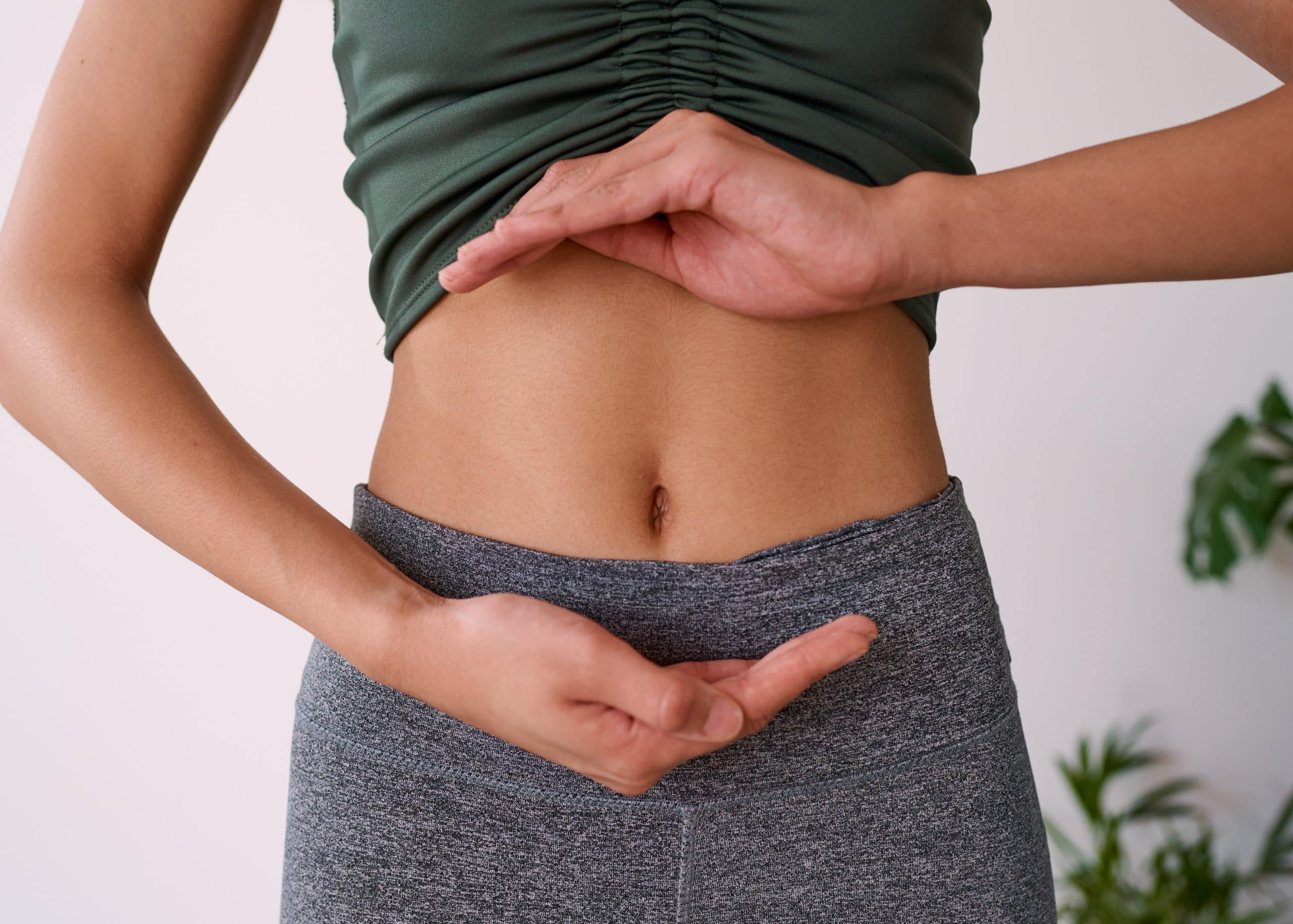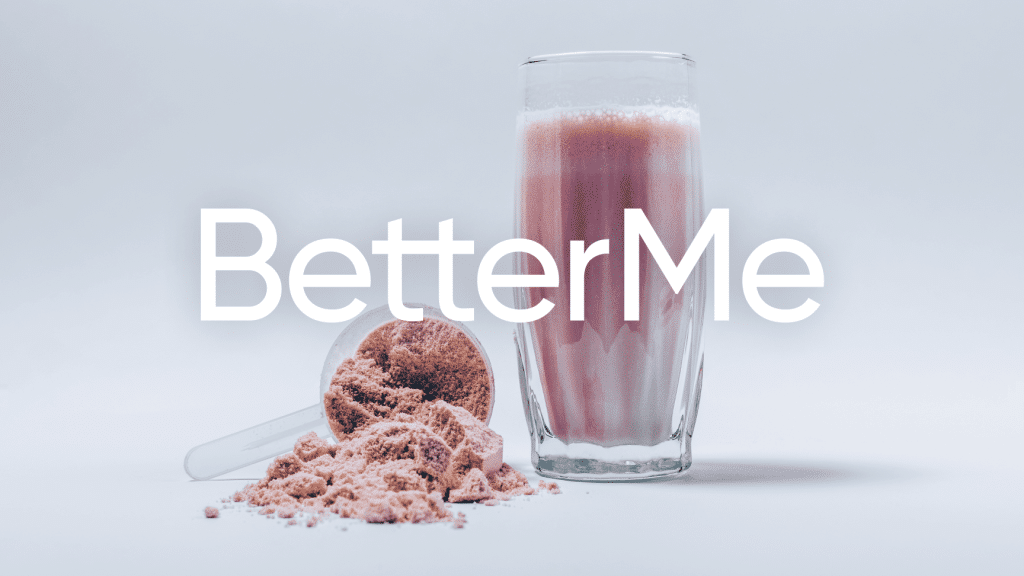People often refer to different “types” of belly fat in a more colloquial sense, referring to where on the body the fat is stored (like lower belly fat, love handles, etc.). However, fat isn’t just an aesthetic issue—it’s a health concern that may increase your risk of various medical conditions. The different types of belly fat can also be categorized scientifically. These categories relate to how fat impacts your health and well-being. The two main types of belly fat, subcutaneous and visceral, have different effects on your health. Understanding the difference between these types can help you formulate an effective strategy to combat them. With that in mind, here’s a look at the different types of stomach fat and how they may impact your health.
Get your personalized
meal plan!
What Are The 2 Types Of Fats In Belly?
There are two types of belly fat: subcutaneous fat and visceral fat.
Subcutaneous fat, the most visually evident type of belly fat, lies directly underneath the skin (16). It’s the layer of soft, palpable fat that you can pinch or grasp with your hand on any part of your body.
It acts as a buffer zone, serving as an energy reserve and providing a layer of insulation to help regulate body temperature. Moreover, it plays a crucial role in storing fat-soluble vitamins A, D, E, and K (10).
In terms of structure, subcutaneous fat consists of adipocytes (fat cells) located within a network of collagen fibers. It’s well vascularized, meaning it has a good blood supply, which is why cuts and wounds in areas with a lot of subcutaneous fat tend to bleed more (17).
However, the thickness of this subcutaneous layer can vary greatly from person to person and between different parts of the body. Factors such as genetics, gender, and age can influence its distribution (22).
For instance, women generally have more subcutaneous fat than men (4), and as people age, they tend to lose subcutaneous fat from the limbs but gain it in the abdominal area.
When you gain weight, it’s usually subcutaneous fat that’s accumulating (2). Many people find this type of fat bothersome for aesthetic reasons, as it can cause cellulite and other alterations in appearance.
While subcutaneous fat may not be as harmful to your overall health, it can still lead to health problems if it accumulates in excess. For instance, having too much subcutaneous fat can increase your risk of developing type 2 diabetes and heart diseaseb (12).
Visceral fat, also known as ‘active fat,’ is located deeper within the abdomen, surrounding our internal organs like the liver, pancreas, and intestines (19). Unlike subcutaneous fat, you cannot see or feel visceral fat as it’s underneath the abdominal muscles.
Visceral fat cells are biologically active, meaning they do more than just sit there. These fat cells function almost like an organ, secreting hormones and substances that can influence various aspects of your health.
Visceral fat cells produce a protein called retinol-binding protein 4 (RBP4) which can increase insulin resistance, potentially leading to Type 2 diabetes (13).
Additionally, visceral fat produces immune system chemicals called cytokines — for example, tumor necrosis factor and interleukin-6 — that can increase the risk of cardiovascular disease by promoting inflammation in the arteries (11).
These cytokines can also influence blood clotting and lead to other health problems.
Structurally, visceral fat is denser and packed more closely than subcutaneous fat. It’s also richer in blood vessels, which is why it appears darker if you were to see it during abdominal surgery.
Interestingly, the distribution of visceral fat also has a genetic component, but it’s heavily influenced by lifestyle factors. Even though everyone has some amount of visceral fat, people who carry weight in the abdominal area (apple-shaped body) may have a higher amount of this type of fat, compared to people who carry weight in the hips and thighs (pear-shaped body) (5).
Read More: Running 1 Mile Calories Burned And How To Maximize Results
What Causes Belly Fat?
There are overlapping causes for the accumulation of both subcutaneous and visceral fat. Some of these common factors include:
Poor Diet
A diet high in processed foods, saturated fats, and simple carbohydrates can lead to weight gain and an increase in both subcutaneous and visceral fat.
Lack Of Physical Activity
Regular physical activity is crucial for maintaining a healthy body weight and fat percentage. A sedentary lifestyle can contribute to overall weight gain and increased fat storage in both subcutaneous and visceral areas.
Stress
Chronic stress can lead to hormonal imbalances, specifically an increase in cortisol levels, which can contribute to the accumulation of both types of fat (15).
Insufficient Sleep
Lack of quality sleep can disrupt your metabolism and cause weight gain, leading to an increase in both subcutaneous and visceral fat (14).
Genetics
Your genetic makeup can influence where your body tends to store excess fat. Some people may be genetically predisposed to carry more weight in their abdominal area, contributing to both subcutaneous and visceral fat (6).
Age And Hormonal Changes
As we age, our metabolism slows down, and hormonal changes can lead to increased fat storage in the abdominal area. This is particularly true for women during menopause, where a drop in estrogen levels can lead to an increase in belly fat (8).
What Shape Is Abdominal Fat?
Abdominal fat doesn’t have a specific shape per se. It’s more about the distribution and accumulation of fat in the abdominal area. There are two types of abdominal fat: subcutaneous fat and visceral fat (18).
Subcutaneous fat is located under the skin and above the abdominal muscles, while visceral fat is stored deeper, around the internal organs within the abdominal cavity.
The “shape” of your abdomen as perceived externally can be influenced by both types of fat. The layer of subcutaneous fat is what you can pinch or feel directly under your skin, and it may give the abdomen a softer, rounded, or pudgy appearance.
On the other hand, an excess of visceral fat can cause the abdomen to protrude or appear bloated, leading to what is commonly referred to as a “beer belly” or “apple-shaped” body (1).
Want to build an attention-grabbing bubble butt, blast away fat that’s stored in all the wrong places, spring-clean your diet, turn back the clock on your skin, skyrocket your self-confidence and shatter your insecurities? Check out the BetterMe app and set this plan in motion!
How Do I Know My Belly Type?
Determining your belly type involves understanding the characteristics of different types of fat and their distribution in your body. Here are some ways to figure out your belly type:
Pinch Test
This is a simple way to check for subcutaneous fat. Pinch the fat around your middle and if you can grab a good amount, it’s likely subcutaneous fat.
Waist Circumference Measurement
Measure your waist circumference at the level of your navel. A waist size over 40 inches for men and over 35 inches for women is considered high and may indicate an excess of visceral fat (23).
Body Shape Consideration
Your overall body shape can also give you clues about your belly type. An “apple” shape, where fat is concentrated in the abdominal area, suggests you may have more visceral fat. A “pear” shape, where fat tends to accumulate around the hips and thighs, indicates that you have more subcutaneous fat.
Health Check-Ups And Scans
For an accurate measurement of visceral fat, health professionals use tools like bioelectrical impedance machines or imaging tests such as CT scans or MRI. These are the most accurate methods but they’re also expensive and not always accessible.
Risk Factors And Health Issues
If you have a high cholesterol level, high blood pressure, or high blood sugar level, you might have more visceral fat.
Read More: Walking 1 Mile Calories: A Detailed Breakdown
What Are The 3 Main Types Of Fat?
In addition to classification according to location (such as subcutaneous and visceral fat), fats can also be categorized based on their body fat and can be classified into three types based on color: white, brown, and beige (or brite) fat.
Each of these types has unique characteristics, functions, and influences on our health.
White Fat
White fat is the most abundant type of fat in adults and it’s what we typically think of when we discuss body fat. This type of fat gets its color from a single large lipid droplet within each cell.
White fat plays a crucial role in energy storage, acting as the body’s reserve fuel supply. When your body needs energy, it turns to these reserves to keep your systems running.
White fat also serves as an insulator to help keep your body temperature stable, and it cushions and protects organs. However, too much white fat, especially stored around the abdomen (visceral fat), can lead to health issues like heart disease, diabetes, and certain types of cancer (20).
Brown Fat
Brown fat, in contrast, has a darker color due to its rich supply of mitochondria – the powerhouse of cells – and blood vessels. Mitochondria are responsible for burning calories to generate heat, explaining why brown fat is often referred to as the ‘good fat.’
This type of fat is more common in babies and hibernating animals, helping them stay warm. Adults have less brown fat, but it’s still present around the neck and shoulders. Recent research suggests that increasing the amount of brown fat in the body may help manage weight and improve overall health (9).
Beige (Or Brite) Fat
Beige or brite (brown-in-white) fat is a hybrid of white and brown fat. Beige fat cells are usually mixed in with white fat deposits. Under certain conditions, such as exposure to cold or certain hormones, these beige fat cells can behave like brown fat cells and burn calories to produce heat.
The discovery of beige fat has excited scientists because it offers the potential to combat obesity and related diseases. If we can find ways to convert white fat cells into beige or brown fat cells, it could open up new avenues for weight management and improving metabolic health.
What Is The Best Way To Burn Belly Fat?
Burning belly fat can be a challenge, but with a strategic approach that includes lifestyle changes and healthy habits, it can be achieved. Here are some effective ways to burn belly fat:
Incorporate Regular Exercise
Exercise is one of the most effective ways to reduce belly fat. It not only burns calories but also improves overall health and boosts metabolism.
Cardiovascular Exercise
Cardio or aerobic exercises like running, cycling, swimming, or brisk walking are great for burning calories and improving heart health. They increase your heart rate and breathing, which helps to burn fat.
Studies have shown that moderate to high-intensity cardio has a significant impact on reducing belly fat (3).
Strength Training
While often overlooked when it comes to burning fat, strength training is crucial as it helps build muscle mass. More muscles mean a higher metabolic rate, which translates to more calories burned, even at rest.
Exercises like weightlifting or resistance training can help you build muscles and boost your metabolism.
High-Intensity Interval Training (HIIT)
HIIT involves short bursts of intense exercise alternated with recovery periods. This type of workout is highly efficient at burning fat. Several studies have shown that HIIT workouts can help reduce belly fat while preserving muscle mass (7).
When it comes to weight loss, progress is made by inches, not miles, so it’s much harder to track and a lot easier to give up. BetterMe app is your personal trainer, nutritionist and support system all in one. Start using our app to stay on track and hold yourself accountable!
Eat A Healthy Diet
Diet plays a significant role in losing belly fat. No matter how much exercise you do, if your diet isn’t balanced, you’ll find it hard to lose fat.
Whole Foods
Focus on incorporating whole, unprocessed foods in your diet. These include fruits, vegetables, lean proteins, and whole grains. They are rich in fiber, which aids digestion and can help you feel full, thereby reducing overeating.
Reduce Sugar And Refined Carbs
Sugary foods, beverages, and refined carbs can lead to increased belly fat. They can spike your blood sugar levels, leading to increased hunger and fat storage. Try to limit your intake of these foods.
Healthy Fats
Contrary to popular belief, not all fats lead to weight gain. Monounsaturated and polyunsaturated fats found in avocados, nuts, seeds, and fish can help reduce levels of ‘bad’ LDL cholesterol and increase ‘good’ HDL cholesterol. They can also make you feel satiated, reducing the likelihood of overeating.
Manage Stress Levels
Stress can significantly affect your body’s ability to lose belly fat. When you’re stressed, your body produces the hormone cortisol, which can lead to weight gain, especially around the waist.
Mindfulness Practices
Techniques such as yoga, meditation, and deep breathing can help manage stress levels. They promote relaxation and can improve mental health, helping to break the cycle of stress and weight gain.
Quality Sleep
Lack of sleep is linked to increased stress levels and weight gain(21). Make sure you’re getting 7-9 hours of quality sleep per night. Establish a regular sleep schedule and create a relaxing bedtime routine to improve your sleep quality.
Leisure Activities
Engaging in activities you enjoy is another excellent way to reduce stress. This could be reading, painting, gardening, or even just taking a walk in nature. Find what works for you and make it a part of your regular routine.
Frequently Asked Questions
What Type Of Fat Helps The Stomach?
Monounsaturated fats and polyunsaturated fats, often referred to as “good fats,” can help improve your metabolic health and stabilize hunger hormones. This can prevent overeating and subsequent fat accumulation in the stomach. Foods rich in these healthy fats include avocados, nuts, seeds, fatty fish, and olive oil.
What Type Of Cardio Burns Stomach Fat?
High-Intensity Interval Training (HIIT) is an effective form of cardio for burning stomach fat. HIIT involves short bursts of intense exercise followed by recovery periods. This form of training keeps your heart rate up and burns more fat in less time, including the belly fat.
What Type Of Exercise To Reduce Stomach Fat?
A combination of regular cardiovascular exercises (like running, swimming, or biking), strength training, and high-intensity interval training can help reduce stomach fat. It’s also beneficial to include exercises that engage the abdominal muscles like planks, crunches, and sit-ups in your workout routine.
What Type Of Exercise Burns Stomach Fat?
No specific exercise can target stomach fat, but high-intensity workouts and strength training can help burn more calories and overall body fat. Exercises that engage multiple muscle groups at once (like burpees, squats, lunges) are particularly effective at burning calories and reducing body fat.
The Bottom Line
Understanding the different types of belly fat and their impacts on health is crucial in maintaining a healthy lifestyle. While some fat is necessary for bodily functions, excess subcutaneous and visceral fat can pose serious health risks.
With a balanced diet, regular exercise, and stress management, you can manage your belly fat and improve your overall health.
DISCLAIMER:
This article is intended for general informational purposes only and does not serve to address individual circumstances. It is not a substitute for professional advice or help and should not be relied on for making any kind of decision-making. Any action taken as a direct or indirect result of the information in this article is entirely at your own risk and is your sole responsibility.
BetterMe, its content staff, and its medical advisors accept no responsibility for inaccuracies, errors, misstatements, inconsistencies, or omissions and specifically disclaim any liability, loss or risk, personal, professional or otherwise, which may be incurred as a consequence, directly or indirectly, of the use and/or application of any content.
You should always seek the advice of your physician or other qualified health provider with any questions you may have regarding a medical condition or your specific situation. Never disregard professional medical advice or delay seeking it because of BetterMe content. If you suspect or think you may have a medical emergency, call your doctor.
SOURCES:
- Abdominal Distension (Distended Abdomen) (2023, clevelandclinic.org)
- Abdominal fat and what to do about it (2019, harvard.edu)
- Effect of High-Intensity Interval Training on Total, Abdominal and Visceral Fat Mass: A Meta-Analysis ( 2018, researchgate.net)
- Gender differences in fat metabolism E Blaak 1 (2001, nih.gov)
- Genetic and Environmental Factors Contributing to Visceral Adiposity in Asian Populations (2020, nih.gov)
- Gene–Environment Interactions on Body Fat Distribution (2019, nih.gov)
- High-Intensity Intermittent Exercise and Fat Loss (2011, nih.gov)
- Hormonal and Metabolic Changes of Aging and the Influence of Lifestyle Modifications (2020, nih.gov)
- How brown fat improves metabolism (2019, nih.gov)
- https://www.ncbi.nlm.nih.gov/books/NBK218749/ (1989, nih.gov)
- Obesity-Induced TNFα and IL-6 Signaling: The Missing Link between Obesity and Inflammation—Driven Liver and Colorectal Cancers (2019, nih.gov)
- Ratio of visceral‐to‐subcutaneous fat area predicts cardiovascular events in patients with type 2 diabetes(2018, nih.gov)
- Serum retinol binding protein 4 is associated with visceral fat in human with nonalcoholic fatty liver disease without known diabetes: a cross-sectional study(2015, nih.gov)
- Sleep Deprivation: Effects on Weight Loss and Weight Loss Maintenance (2022, nih.gov)
- Stress and hormones (2018, nih.gov)
- Subcutaneous adipose tissue & visceral adipose tissue (2019, nih.gov)
- Subcutaneous and visceral adipose tissue: structural and functional differences (2009, nih.gov)
- Subcutaneous Fat (2023, clevelandclinic.org)
- Taking aim at belly fat (2021, harvard.edu)
- Visceral Adiposity and Cancer: Role in Pathogenesis and Prognosis (2021, nih.gov)
- Weight Loss and Sleep (2022, sleepfoundation.org)
- What is Subcutaneous Tissue? (2023, medical.net)
- Why your waist size matters (2023, bhf.org.uk)












